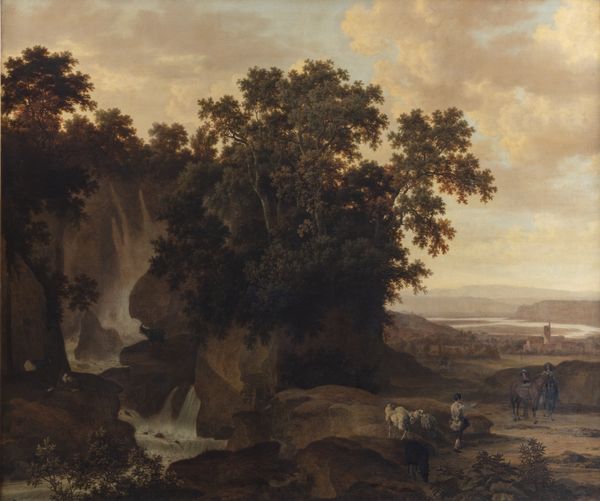
Dimensions: support: 629 x 756 mm
Copyright: CC-BY-NC-ND 4.0 DEED, Photo: Tate
Curator: Samuel Colman's "The Death of Amelia," now held at the Tate, presents a dramatic scene on a support measuring 629 by 756 mm. The artist, who lived from 1780 to 1845, captures a moment heavy with emotion. Editor: It’s devastating, isn't it? The colours alone conjure this overwhelming sense of loss and anguish, like a storm brewing inside. Curator: Absolutely. Colman’s use of swirling dark clouds and the lone figure reaching out suggest not only a personal tragedy but a reflection on the broader societal anxieties of his time, perhaps about mortality and romantic ideals. The material application itself, likely oil on canvas, lends a certain depth and texture that enhances the drama. Editor: I find myself wondering about Amelia. Was her death sudden, tragic? Is this the very moment of realization? The raw vulnerability on display… it almost hurts to look. But it’s a beautiful pain, if that makes sense. Curator: It does, in a way. Colman masterfully combines technique and sentiment, leaving us with a visceral experience of loss and the power of art to evoke such profound empathy. Editor: Yes, a painting that continues to stir the soul.
Comments
tate 8 months ago
⋮
http://www.tate.org.uk/art/artworks/colman-the-death-of-amelia-t02109
Join the conversation
Join millions of artists and users on Artera today and experience the ultimate creative platform.
tate 8 months ago
⋮
The subject is taken from The Seasons, a poem by James Thomson (1700–48), first published in 1727. In ‘Summer’, the poet tells how Amelia is killed by a lightning strike, while in the arms of her love Celadon. He is ‘pierced by severe amazement, hating life / speechless, and fixed in all the death of woe’ as he stands over her corpse. Samuel Colman was based in Bristol, and his subjects tend towards the dramatic and catastrophic. Gallery label, February 2016













